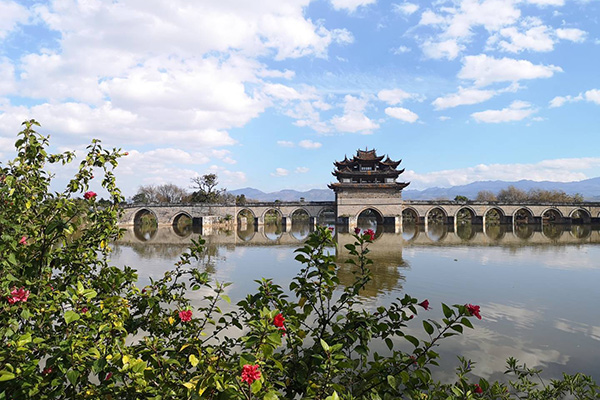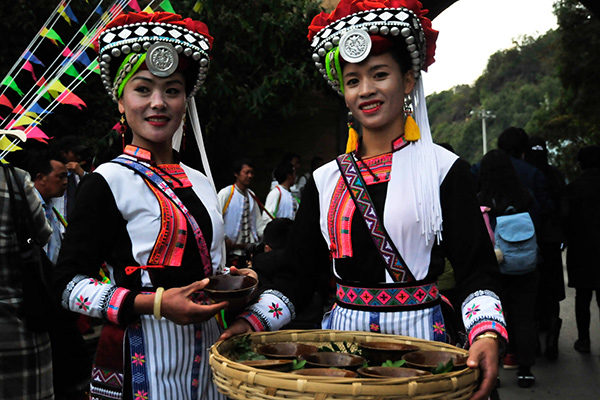
The UNESCO World Heritage site, the Honghe Hani Rice Terraces, in Yunnan province is known for being aesthetically amazing.
And the autonomous prefecture that hosts the attraction is just one part of the province's tourism upgrade.
Its Mi'le city has invested over 3.1 billion yuan ($457 million) on four towns, to improve such aspects as infrastructure and livelihoods. More funds are slated.
Redbrick castles in Dongfengyun town host galleries and boutique hotels.
The Dongfengyun project's marketing manager, Yu Wenjie, says the destination has offered studios to several veteran artists. It has also worked with art schools on programs.
And the town has provided preferential policies to attract young artists.
Local craftspeople will showcase traditional kite-making and calabash-carving events in February.
Nearly 740 Axi people, a branch of Yi ethnic group, inhabit Keyi town.
Modern wall paintings adorn the 370-year-old settlement.
Visitors also enjoy Axi dances, folk arts and produce.
Locals treat guests with songs and toasts.
Tourism and e-commerce have lifted them out of poverty.
"Many villagers like me came back to work in tourism," says local tour guide Zhao Jianmei, 35.

"We lacked a sense of belonging as migrant workers in big cities. It's good that we can make a decent salary and be with our families."
Taiping Lake Forest Town is a destination for its ecological and health tourism.
Visitors stay in wooden houses and recreational-vehicle parks, and enjoy a vast area of flowers like tulips and lilies.
Honghe Shuixiang town is building a standard 8-kilometer-long Formula 3 track with 100,000 seats. They're constructing a carand-motorcycle exhibition center, a commercial street and five-star hotels.
Honghe prefecture's Jianshui county has also upgraded.
It hosts a 700-year-old Confucius temple that hosts traditional ceremonies such as a "first writing ceremony". In ancient times, children would attend the ceremony before entering school life.
The city's food is celebrated, especially since the hit documentary series, A bite of China, popularized its barbecued tofu dipped in spicy sauce.
Typical feasts include about a dozen dishes in purple-ceramic pots, including chicken soup, sausages and vegetables.
Jianshui's purple pottery is made from the local "five-color" clay. It flourished in the Qing Dynasty (1644-1911).
The industry generated about 2.42 billion yuan in output in 2018. Over 1,250 companies are registered in the industry.
Visitors to the county's purplepottery park can visit workshops to make their own creations.
Earthenware made from ancient pinewood-burning kilns is much more expensive than that from modern gas-fired kilns because the output is lower.
"A pinewood kiln will always surprise you. You never know what you'll get until you open it. Each piece has different colors and patterns," says Tong Rucai, production director of Langgui Jianshui Pottery Culture Co Ltd.
He says it takes about 15 days to make a piece after it's fired in a kiln. Controlling the technique is about overcoming multiple failures to get the colors right.
Jianshui county's tourism bureau's head Yao Guangbing says: "The old technique was passed down orally from masters to disciples and fathers to sons. Nowadays, more people graduate from specialized schools. They bring new ideas into the industry."
Jianshui's minsu (Chinese-style bed-and-breakfasts) have attracted more overnight tourists. They enjoy traditional singing-and-dancing shows and visit a street lined with purple pottery stores.
Highways linking Jianshui, Kunming and Yuanyang county will be finished soon, he says. Jianshui is centrally located in the region, in every sense, since it's between Kunming and the Hani terraces.
It may become a place connecting the appeals of a region that were once more dispersed and an intermediary for travelers in the greatest sense of the term.(By XU LIN/LI YINGQING)

